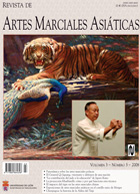O general Qi Jiguang, visionário e defensor de uma nação
DOI:
https://doi.org/10.18002/rama.v3i3.374Palavras-chave:
Artes marciais, ChinaResumo
No ano 1550 d.C. o esplendor da Dinastia Ming da China viu-se ameaçado por forças estrangeiras tanto a Norte como nas costas do Leste. O surgimento de um dos generais mais famosos da sua história, o general Qi Jiguang, mudaria a forma como a China havia até então organizado as suas forças armadas, ao ponto de se formar o primeiro exército profissional da sua história. O seguinte artigo discutirá as contribuições do general Qi Jiguang e o seu legado, o qual se vê representado num dos exércitos mais poderosos do mundo: o Exército Popular de Libertação da China.
Downloads
Métricas alternativas
Referências
Acevedo, William (2008). “A Lifetime Dedicated to the Martial Traditions, An Interview with Professor Ma Mingda”. Inside Kung Fu Magazine, en evaluación.
Gewu, Kang (1995). The Spring and Autumn of Chinese Martial Arts, 5000 Years. Santa Cruz, CA: Plum Publications.
Goodrich, Luther Carrington y Fang, Chao-ying (1976). Dictionary of Ming Biography, 1368-1644. New York: Columbia University Press.
Graff, David A. y Higham, Robing (2002). A Military History of China. Boulder (Colorado): Westview Press.
Harrison, Cassian y Bradley, Richard (Prod.) (2008). Behind the Great Wall. Documental by Discovery Channel.
Henning, Stanley (1999). “Chinese Boxing’s Ironic Odyssey”. Journal of Asian Martial Arts, 8(3), 8-17.
Henning, Stanley (1998). “Southern Fists and Northern Legs, The Geography of Chinese Boxing”. Journal of Asian Martial Arts, 7(3), 24-31.
Henning, Stanley (1981). “The Chinese Martial Arts in Historical Perspective”. Military Affairs, 45(4), 173-179.
Henning, Stanley (1995). “General Qi Jiquan’s Approach to Martial Arts to Martial Arts Training”. Journal of Chen Style Taijiquan Research Association of Hawaii, 3(2), 1-3.
Kennedy, Brian y Guo, Elizabeth (2005). Chinese Training Manuals, A Historical Survey. Berkeley, CA: North Atlantic Books.
Kim, Sang H. (2000). Muye Dobo Tongji, The Comprehensive Illustrated Manual of Martial Arts of Ancient Korea. Hartford, CT: Turtle Press.
Larsen, Matt (2002). MCAP Modern Army Combatives Program. US Army. DVD 7.01.
Ping, Duan y Shouzhi, Zheng (2007). Chinese English and English Chinese Wushu Dictionary. Beijing: China People’s Republic Sports Publishing House.
Qi Jiguang 戚继光 (1528-1587) (1985). Jixiao Xinshu 紀效新書 [Libro de la Disciplina Efectiva]. Editado por Ma Mingda 馬明達
Qi Jiguang 戚继光 (1528-1587). (2001) Lien Ping Shih Chi 練兵實紀 [Recuento Práctico del Entrenamiento de Tropas].
Shahar, Meir (2008). The Shaolin Monastery, History, Religion and The Martial Arts. Honolulu: University of Hawaii Press.
Wile, Douglas (1999). T’ai Chi’s Ancestors. New York: Sweet Ch’I Press.
Downloads
Publicado
Como Citar
Edição
Secção
Licença
Direitos de Autor (c) 2012 William Acevedo, Mei Cheung

Este trabalho encontra-se publicado com a Licença Internacional Creative Commons Atribuição-NãoComercial-CompartilhaIgual 4.0.
Os autores que publicam nesta Revista estão de acordo com os seguintes termos:
- Os autores cedem, de forma exclusiva, os direitos de exploração (reprodução, distribuição, comunicação pública, transformação) à Universidade de Léon, podendo estabelecer, em separado, acordos adicionais para a distribuição não exclusiva da versão do artigo publicado na Revista (por exemplo: alojar no repertório institucional ou publicá-lo num livro), com o reconhecimento da publicação inicial nesta Revista.
- O trabalho encontra-se na Creative Commons Attribution-Non Commercial-Share Alike 4.0 International License. Pode-se consultar aqui o resumo e o texto legal da licença.
- Permite-se, e sugere-se, que os autores difundam electronicamente as versões pré-impressão (versão antes de ser avaliada) e pós-impressão (versão avaliada e aceite para publicação das suas obras antes da sua publicação), favorecendo a sua circulação e difusão, e com ela o possível aumento da sua citação e alcance pela comunidade académica.











